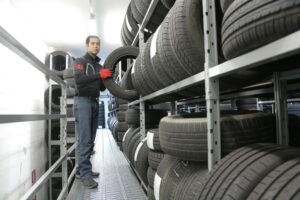Introduction:
Owning a car brings convenience and freedom, but it also comes with responsibilities. Regular maintenance is key to ensuring your vehicle runs smoothly and safely for years to come. In this detailed guide, we’ll walk you through a comprehensive car maintenance checklist, covering essential tasks that every car owner should prioritize.

| Outline | |
|---|---|
| I. Importance of Car Maintenance | |
| A. Ensuring Safety | |
| B. Extending Vehicle Lifespan | |
| C. Preserving Resale Value | |
| II. Regular Maintenance Tasks | |
| A. Checking Fluid Levels | |
| B. Inspecting Tires | |
| C. Changing Oil and Filters | |
| D. Checking Brakes | |
| E. Replacing Wiper Blades | |
| F. Testing Lights | |
| G. Monitoring Battery Health | |
| III. Seasonal Maintenance | |
| A. Winter Preparation | |
| B. Summer Care | |
| IV. Advanced Maintenance | |
| A. Engine Tune-Up | |
| B. Transmission Service | |
| C. Suspension and Steering | |
| V. Interior and Exterior Care | |
| A. Cleaning and Detailing | |
| B. Upholstery Maintenance | |
| VI. DIY vs. Professional Maintenance | |
| A. Pros and Cons | |
| B. When to Seek Professional Help | |
| VII. Common Car Maintenance Mistakes | |
| A. Neglecting Regular Checkups | |
| B. Using Incorrect Fluids | |
| C. Ignoring Warning Signs | |
| VIII. FAQs about Car Maintenance | |
| A. How often should I change my oil? | |
| B. When should I replace my tires? | |
| C. Is it necessary to rotate tires regularly? | |
| D. How can I tell if my brakes need replacing? | |
| E. Why is it important to check coolant levels? | |
| F. What should I do if my check engine light comes on? |
I. Importance of Car Maintenance
Ensuring Safety
Regular maintenance is crucial for ensuring the safety of both you and your passengers. Faulty brakes, worn tires, or engine issues can all contribute to accidents on the road.
Extending Vehicle Lifespan
By taking care of your car through routine maintenance, you can significantly extend its lifespan. Addressing small issues promptly can prevent them from escalating into more significant and costly problems down the line.
Preserving Resale Value
A well-maintained car commands a higher resale value. Potential buyers are more likely to pay a premium for a vehicle with a documented history of regular maintenance and care.
II. Regular Maintenance Tasks
Checking Fluid Levels
Regularly check and top up essential fluids such as oil, coolant, brake fluid, and windshield washer fluid to ensure optimal performance.
Inspecting Tires

Inspect tire pressure, tread depth, and overall condition regularly. Rotate tires as recommended and replace them when necessary to ensure safety and performance.
Changing Oil and Filters
Follow the manufacturer’s guidelines for oil changes and filter replacements. Fresh oil and clean filters are essential for engine health and longevity.
Checking Brakes
Regularly inspect brake pads, rotors, and brake fluid levels. Address any signs of wear or deterioration promptly to maintain braking efficiency.
Replacing Wiper Blades
Ensure clear visibility in all weather conditions by replacing worn wiper blades regularly.
Testing Lights
Check all exterior lights, including headlights, taillights, brake lights, and turn signals, to ensure they are working correctly.
Monitoring Battery Health
Inspect the battery terminals for corrosion and ensure a secure connection. Test the battery’s voltage regularly, especially before long trips.
III. Seasonal Maintenance
Winter Preparation
Prepare your car for winter by checking the antifreeze level, ensuring proper tire traction, and keeping emergency supplies on hand.
Summer Care
Perform maintenance tasks such as checking coolant levels, inspecting the air conditioning system, and protecting the exterior from sun damage.
(Ensure Your Car’s Longevity: A Comprehensive Car Maintenance Checklist for Every Owner)
IV. Advanced Maintenance
Engine Tune-Up
Schedule regular tune-ups to optimize engine performance and fuel efficiency.
Transmission Service
Follow the manufacturer’s recommendations for transmission fluid changes and inspections to prevent costly repairs.
Suspension and Steering
Inspect suspension components and steering systems for signs of wear or damage, addressing any issues promptly to ensure a smooth and safe ride.
V. Interior and Exterior Care
Cleaning and Detailing

Regularly clean both the interior and exterior of your car to maintain its appearance and prevent corrosion.
Upholstery Maintenance
Protect and preserve your car’s upholstery by cleaning spills promptly and using appropriate cleaners and conditioners.
VI. DIY vs. Professional Maintenance
Pros and Cons
Consider the benefits and drawbacks of performing maintenance tasks yourself versus seeking professional assistance.
When to Seek Professional Help
Know when it’s time to consult a qualified mechanic for complex repairs or specialized services.
VII. Common Car Maintenance Mistakes
Neglecting Regular Checkups
Skipping routine maintenance can lead to costly repairs and compromise your safety on the road.
Using Incorrect Fluids
Using the wrong type of oil or coolant can damage your car’s engine or cooling system.
Ignoring Warning Signs
Pay attention to warning lights or unusual sounds and address them promptly to prevent further damage.
VIII. FAQs about Car Maintenance

How often should I change my oil?
Regular oil changes are typically recommended every 5,000 to 7,500 miles, but check your owner’s manual for specific intervals.
When should I replace my tires?
Replace tires when the tread depth reaches 2/32 of an inch or if you notice signs of uneven wear or damage.
Is it necessary to rotate tires regularly?
Yes, rotating tires regularly promotes even wear and extends tire life. Aim to rotate them every 6,000 to 8,000 miles.
How can I tell if my brakes need replacing?
Signs of worn brakes include squeaking or grinding noises, vibrations while braking, or a longer stopping distance.
Why is it important to check coolant levels?
Coolant helps regulate engine temperature and prevents overheating, so maintaining proper levels is essential for engine health.
What should I do if my check engine light comes on?
If the check engine light illuminates, it indicates a potential issue with your vehicle’s engine or emissions system. Schedule a diagnostic check as soon as possible to identify and address the problem.




